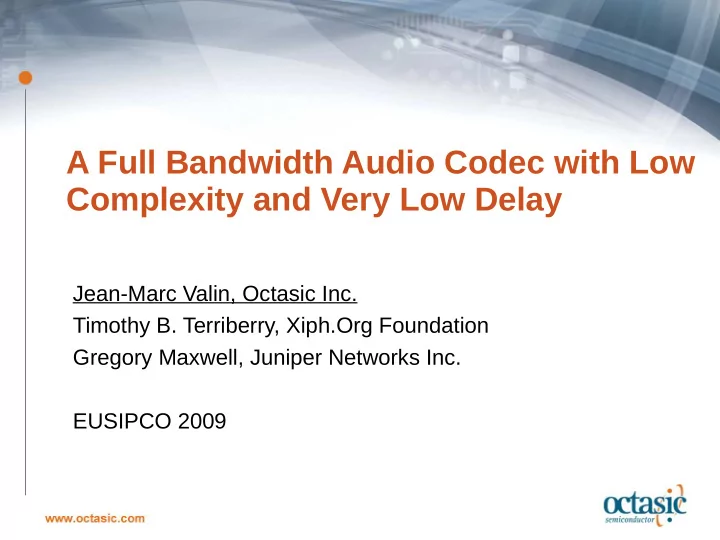

A Full Bandwidth Audio Codec with Low A Full Bandwidth Audio Codec with Low Complexity and Very Low Delay Complexity and Very Low Delay Jean-Marc Valin, Octasic Inc. Timothy B. Terriberry, Xiph.Org Foundation Gregory Maxwell, Juniper Networks Inc. EUSIPCO 2009
Introduction ● Motivations for very low delay ● Delay-sensitive applications (e.g. live network music) ● Reduces perception of acoustic echo ● Codec characteristics ● Speech and music at 48 kHz ● 5.3 ms frame size (256 samples), 2.7 ms look-ahead ● 48-128 kb/s per channel (adaptive) ● Support for frames sizes of 64 – 512 samples slide 2
Overview ● Constrained-Energy Lapped Transform (CELT) ● Basic principles ● MDCT spectrum divided into critical bands ● Band energy explicitly coded, constrained at decoder ● Spectral “details” coded with spherical codebook ● Bit allocation based on shared information slide 3
Encoder Block Diagram + Fine energy _ Band Coarse Range Bit-stream energy energy coder z x Audio Window MDCT / PVQ Desired Bit Quantizers bit-rate allocation slide 4
Transform, Bands ● Modified Discrete Cosine Transform (MDCT) ● Low-overlap window ● Divided into critical bands (except low frequencies) ● Implications of short frame size ● Poor frequency resolution and leakage ● High cost of “side information” slide 5
Energy Quantization ● Energy computed for each critical band ● Coarse-fine strategy ● Coarse energy quantization ● Scalar quantization with 6 dB fixed resolution ● Prediction in time (previous frame) and frequency ● Range-coded with Laplacian probability model ● Fine energy quantization ● Variable resolution (based on bit allocation) ● Not entropy-coded ● Any error in the energy quantization is not compensated in the later quantization stages slide 6
PVQ Codebook ● Quantizing N -dimentional vectors of unit norm ● N -1 degrees of freedom (hyper-sphere) ● Pyramid Vector Quantizer [Fischer, 1986] ● Algebraic codebook (no table stored) ● Combinations of K signed “pulses” ● Set of vectors y such that || y || L1 = K ● Mapped onto the hyper-sphere: x = y / || y || L2 ● Fast search and indexing algorithms ● Index is range-coded (flat probability) slide 7
Perceptual Improvements ● Pre-echo control ● Multiple smaller MDCTs, interleaved spectra ● Energy computed as if a single MDCT ● “Birdie” avoidance ● Adding an “offset” to PVQ quantization ● Based on lower part of the spectrum ● Gain = N / ( N + 6 K ) slide 8
Bit Allocation ● Fundamentally a CBR codec (VBR supported) ● Synchronized allocator in encoder and decoder ● Allocates fine energy bits and PVQ bits ● Depends only on shared information ● Number of compressed bytes ● Number of bits used so far by the range coder ● Near-constant bits per band in time ● Models within-band masking with near-constant SMR ● Does not model inter-band masking, tone vs noise ● Implicit psycho-acoustic model (not coded) slide 9
Allocation Example (64 kb/s) slide 10
Evaluation ● MUSHRA listening tests (10 listeners) ● CELT version 0.5.0 (proposed) ● FhG ULD: warped LPC, pre-filtering ● G.722.1C: MDCT, scalar quantization, uniform bands slide 11
Results slide 12
Complexity and RAM ● Complexity (encoder+decoder average) ● 17 WMOPS in fixed-point ● 27 MHz on Intel Core2 (unoptimised floating-point C) ● State data (per channel) ● Encoder: 0.5 kB ● Decoder: 0.5 kB (+ 4 kB for PLC) ● Scratch space ● Encoder+decoder: ~7 kB slide 13
Conclusion ● Low-delay coded, explicit energy constraint ● Work in progress ● Pitch prediction ● Stereo coupling ● Submitted to IETF as Internet codec proposal ● Resources ● Source code: http://www.celt-codec.org ● Mailing list: celt-dev@xiph.org slide 14
Questions? Ask me for audio samples after the session slide 15
Other Frame Sizes -0.5 -1.0 -2.0 -3.0 Overhead is about 42 bits/frame slide 16
Recommend
More recommend